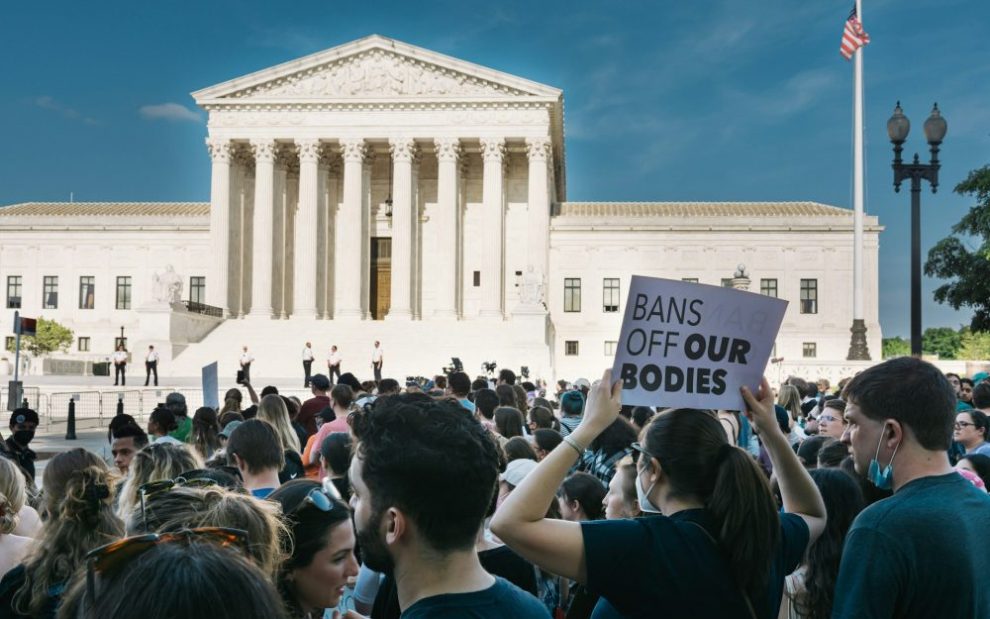More than two years have passed since Roe v. Wade was overturned in the Dobbs v. Jackson Women’s Health decision, in which the Supreme Court justices ruled that the “Constitution does not confer a right to abortion” and that the “authority to regulate abortion” is returned to the states.
Since then, 14 states have enacted total abortion bans that make abortion illegal after conception or, in a few states, after six weeks of pregnancy. In states where abortion remains legal, state legislators have passed additional laws further protecting abortion rights and shielding people who travel from out of state to get an abortion from legal persecution. This November, at least 11 states could have abortion-related questions on the ballot.
The Catholic Church is one of the largest entities opposing abortion in the United States. Through years of lobbying, the Catholic Church had a large role in the political momentum of overturning Roe.
Yet, in 2022, 68 percent of Catholics said Roe should not be overturned, according to a study from the NORC Center for Public Affairs Research. And in the days after Roe fell, 64 percent of white Catholics and 75 percent of Hispanic Catholics said they supported legal abortion in most or all cases, according to the Public Religion Research Institute.
Emily Reimer-Barry, a theologian and professor at the University of San Diego who wrote Reproductive Justice and the Catholic Church (Rowman & Littlefield), says when it comes to abortion discourse in the United States, she encourages Catholic voters to look beyond superficial and routine talking points, and “analyze the platforms of both parties on the basis of not only rhetoric around abortion but policies adjacent to abortion.”
Issues such as taxation policies, access to health care, relationship violence, housing, and jobs that pay fair wages “might not seem to be pro-life or pro-choice issues, but they are deeply related to the ways that women facing unplanned pregnancies will negotiate their decision,” Reimer-Barry says. “Neither political party aligns neatly with the broad range of Catholic teachings. So it’s going to mean careful discernment about how to weigh these very complex issues.”
The impacts of Dobbs
Even with abortion bans, people are still seeking abortions. Over a million abortions were performed in 2023, which is the highest yearly abortion rate measured in a decade. According to the Guttmacher Institute, more than 170,000 patients seeking abortions traveled out of state in 2023 to receive one. Clinics in states where abortion is legal are seeing more patients from out of state, which creates longer wait times. In addition, some clinics have had to limit other forms of sexual and reproductive care due to the volume of people seeking abortions.
Abortion is legal in 27 states; many states legislate abortion based on how many weeks into the pregnancy a woman is. Some limit abortion after fetal viability at around 23 weeks, or when a fetus is able to survive on its own outside the womb. Nine states and the District of Columbia have no limit on when an abortion can be given.
The additional costs associated with traveling for abortion are “very real for women,” Reimer-Barry says. “There will be some women who will not be able to access those resources to travel. And so they might feel that their pregnancy has to continue because they can’t pay for the care that they seek.”
Forced or coerced pregnancy because of restrictive abortion laws and lack of resources is something Reimer-Barry would not consider a “win for the pro-life movement. Any kind of moral coercion could be spiritually damaging. I think it’s much better for us, as a church, to focus on persuasion, not coercion in terms of our tactics and public policy,” she says.
She also points to how “stigma and shame persist” in Catholic contexts, where “there’s still a black-and-white way of talking about abortion discernment or pregnancy discernment with this assumption that good women will want to continue pregnancies,” she says. “That doesn’t reflect the reality of all women’s experiences.”
Many women, for example, find themselves in medical situations where they can’t continue their pregnancy. “We could describe those kinds of complications as tragic,” Reimer-Barry says. “Sometimes in diagnoses of serious health threats to the woman, she might feel that the best decision is to not continue the pregnancy, yet depending on her state, she might not be able to access that care in a timely fashion.”
Reimer-Barry notes how legal restrictions on abortion—and how abortion is defined—impact people who may need care for a spontaneous abortion (miscarriage) or an indirect abortion, including procedures like D&C (Dilation and Cutterage). Some doctors in states with total abortion bans have become hesitant to provide this procedure altogether. Catholic moral tradition recognizes that spontaneous abortions and indirect abortions are “permissible and incur no guilt,” Reimer-Barry says. “There are ways in which some of the legal abortion bans even exceed some of the rigor of traditional Catholic teachings around pregnancy care.”
Another reason for the increase in the abortion rate, despite the bans, is the availability of medication abortion, which was used in two-thirds of abortions last year. Medication abortion works by taking two pills—mifepristone and misoprostol. Mifepristone blocks production of the hormone progesterone, which the body needs to continue pregnancy. Misoprostol causes bleeding and heavy cramping, which empties the uterus. Mifepristone is also used in miscarriage care.
In 2020, the Institute of Labor Economics found that the majority of people seeking abortions are low-income and have previously given birth. According to the same study, in the first six months of 2023, births rose about 2.3 percent in states with total abortion bans.
After the Dobbs decision, the JAMA network conducted a study looking at self-managed abortion attempts, meaning any action taken to end a pregnancy without medical supervision. The study found that self-managed abortions have increased since Dobbs, including self-sourcing medication abortion pills, “ingesting herbs, alcohol, or other substances; or using physical methods such as punching oneself in the stomach.” The study found that self-managed abortion was higher among socially marginalized groups.
Pro-life and pro-choice movements
The pro-life and pro-choice movements are social movements that have evolved over time, Reimer-Barry says. Today, pro-life movements include many different voices and motivations, and there is no one spokesperson. “The pro-life movement seeks to protect policies that affirm human life at every stage of existence,” she says. “And there tends to be a comfort level among folks who identify as pro-life with abortion restrictions or even with abortion bans.”
On the other hand, the “social pro-choice movement tends to talk about access to abortion as a human right,” she says. Reimer-Barry, who has studied the history of the pro-life and pro-choice movements, says “neither the pro-life movement nor the pro-choice movement is, let’s say, morally pure. Members of the pro-life movement have been influential not only in shaping policies that prevent women from accessing medical care, but they’ve also been part of social movements that undermine racial justice.”
In the presidential debates of 1968 and 1984, for example, Republican politicians used abortion as a wedge issue, but they were also involved in projects that undermined the goals of the civil rights movement. They also wanted to “increase a traditional family values approach that reinstated patriarchy within family systems as God’s design for marriage and family,” Reimer-Barry says.
In contrast, the pro-choice movement tended to emphasize women’s equality, but “some of the leaders of the pro-choice movement tended to emphasize the rights of white women and excluded the concerns of women of color,” she says. The pro-choice movement also has historical ties to the eugenics movement in the United States, Reimer-Barry writes in her book, providing a “warning about how social policies regarding the ‘right’ to control one’s fertility can be distorted as a ‘duty’ for those who lack social privilege.”
Pro-choice Christians “do not necessarily identify abortion as a moral good, but they are not comfortable with pro-life goals of reducing or eliminating women’s access to abortion,” Reimer-Barry writes in her book. They would say that “fetal life is a value but is not the only value at stake.”
Jamie Manson, the president of Catholics for Choice, says that in church spaces, the “punishments for questioning the church’s teaching about abortion are very severe. People lose their ministries, they lose their jobs, they can lose their families if they come out about their pro-choice values. There’s so much silence and stigma.”
Manson says she recognizes that for many Catholics, abortion is a morally complicated, ethically fraught issue with no easy or simple answers. Catholics for Choice hosts “values clarification workshops,” Manson says, where 20 to 30 people enter into discussion, discernment, and respectful dialogue about abortion.
“It’s not a workshop designed to make people pro-choice—it’s designed for people to clarify what their actual convictions are about abortion, because the issue is so fraught and stigmatized. I think most people don’t know what they actually believe about abortion,” Manson says.
Within the past 15 years, Reimer-Barry says, abortion and euthanasia have become “moral non-negotiables” to U.S. bishops. In the 1930s and ’40s, Catholic bishops and priests coupled their opposition to abortion, contraception, and sterilization with a call for “government social programs, aid to the impoverished, and a living wage for workers,” she writes.
“When Catholic bishops first began their work of anti-abortion advocacy, they did not engage in single-issue politics,” Reimer-Barry writes. This multi-faceted approach was sidelined after Roe in 1973, in part to help build coalitions with conservative Christian leaders opposed to legal abortion.
Today, the prioritization of abortion and euthanasia as moral non-negotiables “raises up those issues above other very valid and important issues,” Reimer-Barry says, especially when it comes to voting. “I want to take issue with that and say that the voter today needs to discern all of the complex moral issues that face our country,” she says.
Pro-life work post-Roe
Jack Champagne is the current executive director of Rehumanize International, an organization that advocates for a consistent ethic of life—they are “anti-abortion, anti-euthanasia, anti-death penalty, and anti-war,” he says.
Champagne says he’s seen a cultural shift in how abortion politics are conducted in the United States since the Dobbs decision. “I think the mainstream opinion prior to Dobbs was that [abortion] is mainly a privacy issue, that it’s a medical decision between a woman and her doctor, and it’s not the state’s role to get involved with that,” he says. He saw a shift after Dobbs to many people viewing abortion as a human right that should be protected and defended.
“After Dobbs, there was a flurry of pro-life people being like, here is our chance to [change people’s opinions],” Champagne says. “They realized pretty quickly that the national mood was not there. A lot of attempts to restrict abortions through referendums failed. A lot of attempts to expand legal protections for abortion did succeed.”
This shift made the overturning of Roe a “double-edged sword,” Champagne says. “It is now an issue that we can move on politically, but the issue has polarized so far in the opposite direction that we wanted to go.”
Champagne sees evidence of this in how politicians at the Republican National Convention this year “moderated their position on abortion quite a bit compared to their previous few platforms.” He also cites the Freedom of Access to Clinic Entrances (FACE) Act, which has led to charges against anti-abortion activists who obstruct entrances to abortion clinics, among other actions. Rehumanize’s previous executive director, Herb Geraghty, was prosecuted under the FACE act and is currently incarcerated. These laws have created a “chilling effect in people with anti-abortion opinions not wanting to risk engaging in direct activism,” Champagne says.
The end of Roe, Champagne says, “was not a victory. It was not the end point. Roe was a barrier, but now that it’s gone, you have to do the hard work of convincing people of the dignity of the unborn life.”
When it comes to voting, “there’s a lot of room for acceptable disagreement among Catholic voters,” Champagne says, but political activity doesn’t stop when you vote.
“People were willing to tolerate Biden, but then were willing to hold him accountable,” he says. “Same thing with Trump. People felt that he was the more pro-life candidate, but if they were consistent, they should have been keeping him accountable for his border policy. So it’s a matter of not expecting too much from politicians, and also not identifying too strongly with who’s in power so that you are not led into that trap of having to justify everything they do, even when it is against what you stand for.”
Andrea Trudden, the vice president of communications and marketing for Heartbeat International, an organization that runs pregnancy centers and maternity homes throughout the world, says it’s important for Catholic voters to dig into the platforms of “people that they’re voting for in their states, specifically on the life issue.”
Trudden says the pregnancy health centers offer free ultrasounds and other resources, and part of their mission is trying to help a pregnant woman figure out how she can continue her pregnancy, dissuading her from abortion.
One aspect of Heartbeat International’s work that has changed post-Roe is the increasing availability of abortion pills, Trudden says. Heartbeat International is involved in efforts to offer “abortion pill reversal” at their pregnancy centers. “If a woman takes the first part of the two-part abortion pill and then regrets that choice, we can help her reverse that option with progesterone,” she says. (Editors’ note: While this practice is being increasingly done in crisis pregnancy centers, there is no medical evidence to support it. Many organizations, including the American College of Obstetricians and Gynecologists, caution against such procedures due to the lack of testing and possibility of harmful side effects, including hemorrhage.)
For many women in states with restrictive laws, fear of legal retaliation make them less likely to seek medical help if there are complications with their medication abortion.
Nuances in views on abortion
In 2022, the Archdiocese of Kansas City spent well over a million dollars campaigning to end Kansas’ abortion rights. The ballot measure didn’t pass. Before the election, Sister Angela Fitzpatrick, one of the founders of NETWORK, and Sister Michele Morek, both local women religious, wrote a letter to the Kansas City Star that they would be voting to keep abortion rights protected in the state.
“Has the Legislature recently helped create an environment supporting pro-life choices by providing better health care, parental leave, Medicaid expansion and other support for poor women—or day care and child support for babies?” the sisters wrote, adding: “We will vote no on the amendment to preserve individual freedom, the rights of women and our democracy.”
In other states, such as Ohio and Florida, Catholic bishops have contributed or are planning to contribute millions to defeat ballot initiatives on abortion rights. Manson says the issue of abortion is often not as politicized and polarized in other countries’ Catholic churches as it is in the U.S. church, specifically with the bishops, who have made it the “preeminent issue.” Catholics for Choice does work in other parts of the world, such as Latin America and Sub-Saharan Africa.
Manson urges Catholic voters to consider the social justice ramifications that accompany abortion bans. “When abortion bans and restrictions go into place, it is the poor who suffer the most, it is people in rural areas who are already suffering from racism, poverty, and economic injustice,” she says.
Dialogue in the church
Reimer-Barry, who takes a pastoral approach to listening to women’s stories of pregnancy loss, says she gets “frustrated when clerical leaders use the term sin to describe abortion because that connotes such a technical term within our tradition.” Given the ways that “structural injustices impact women’s discernment around pregnancy, it’s not clear to me that every decision to terminate a pregnancy is automatically a sin,” she says.
She hopes Catholics will “try to learn from the stories of women who’ve experienced various kinds of pregnancy loss and recognize that women in the pews are, in many cases, suffering,” she says. It’s harmful, Reimer-Barry says, when priests and bishops call women who have abortions murderers and criminals. “The terminology that’s used to describe their decisions from the pulpit can further increase their spiritual alienation and can be counterproductive if we want to provide spaces for healing and growth.”
For members of the clergy, “I would like to see a posture of sensitivity and openness instead of preaching moral absolutism.” Reimer-Barry says. “I don’t believe that God abandons women who are doing the best they can in a really difficult situation.”
Reimer-Barry hopes to see the church move toward an understanding of the role of accompaniment. This is a theme that Pope Francis has emphasized, she says: “Not finger pointing and shaming or rebuking someone else’s decision,” but rather being in community and solidarity. “A vote in a Catholic context is not about my personal self-interest,” she says. “It’s about how my vote is going to shape the common good.”
Image: Unsplash/Gayatri Malhotra













Add comment